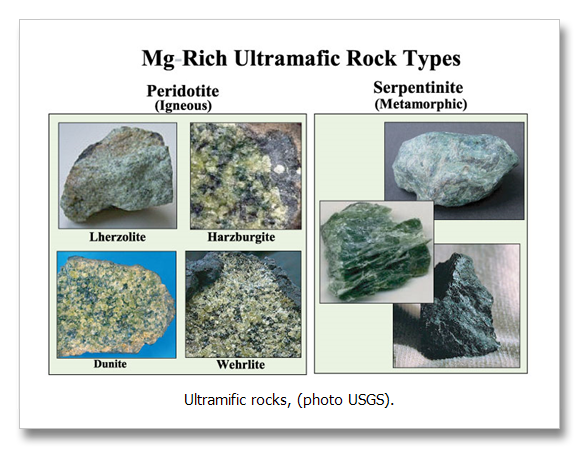With the IPCC suggesting strong negative emissions, or strong removal of atmospheric carbon, as the only way to avoid dangerous climate change (see here), we have no choice. We must remove already emitted carbon dioxide from our skies.
The U.S. Geologic Survey (USGS) is looking at one of the better ways of doing this using rocks that really like to suck carbon out of the air. They even have a superhero rock name: ultramific rocks.
The technique can be used in-situ, or ex-situ. that is, in the ground by injection, or dig the rocks up, pulverize them and inject CO2. The results are rocks with extra CO2 (they are called mineral salts, but do not be confused by the salt term. They are as stable as limestone and will not leak back into the atmosphere.)
These rocks suck carbon dioxide at an amazing rate at room temperature. Increase the temperature a little and the rate increases dramatically. Worried about energy requirements? The chemical reaction that occurs between ultramific rocks and CO2 is exothermic—it produces heat. So once the reaction is started the rocks heat up and efficiency increases.
The beauty of using ultramific rocks is that air capture can be deployed anywhere there are ultramific rocks. The USGS has identified enough ultramific rocks in the U.S. alone to satisfy global sequestration needs for 125 years.
Costs range widely with very little academic work on the subject and a range from $10 to over $100 per ton. The lack of funding of mineral sequestration is embarrassing to say the least. Almost $7 billion federal dollars have been spent on research and development on methods to capture carbon from flue gas. The total federal investment for CO2 capture from air may be as little as $300,000. Using air capture funding as a metric, sequestration research is likely badly underfunded as well.
http://crustal.usgs.gov/projects/CO2_sequestration/index.html
Mineral sequestration: MIT
http://igutek.scripts.mit.edu/terrascope/?page=Basalt
Air Capture Research:
Jones, Removing Carbon Dioxide from the Atmosphere: Possibilities and Challenges of Air Capture, page 13, Frontiers of Engineering, National Academy of Engineering Symposium 2012, National Academy of Sciences. page 16, fourth paragraph.
http://www.nap.edu/openbook.php?record_id=18185&page=13
Cost of mineral sequestration: Lackner’s shipping container sized process would work if we built 10 million of them per year. Comparatively, we build 70 million automobiles per year.
http://www.iddri.org/Evenements/Seminaires-reguliers/130528_sddee%20presentation%20Lackner.pdf

